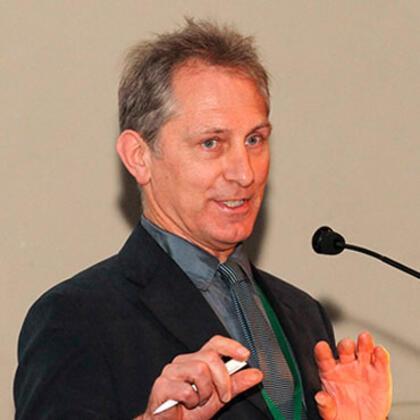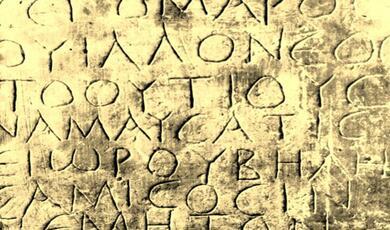Protecting London - Digging up old London
Share
- Details
- Text
- Audio
- Downloads
- Extra Reading
This lecture explores the challenges in uncovering the origins and early development of London through archaeological excavation. It looks at how those involved must balance the safeguarding and preservation of London's ancient architecture with the potential gains for historical understanding from findings yet to be discovered.
Download Text
EARTH: DIGGING UP OLD LONDON
Dr Gustav Milne
The City's origins and early development are not explicitly described in the meagre haul of written accounts of Roman and early medieval London that still survive: we do not even have a reliable recorded date for the foundation of London in any contemporary documentary source, for example. Consequently, we must turn from the written records to the material remains to build up a picture of our distant past, a picture that only a painstaking archaeological study can provide.
In spite of its crucial importance to our understanding of London's past, the development of the provision for archaeological excavation in the City is a tortuous tale. London has had to redevelop to survive economically, to allow for new infrastructure such as main drainage, new streets or railways, and also to rebuild after disasters such as the Great Fire of 1666 and the Blitz in the 1940s. The layers of London's underlying Roman, Saxon and later medieval occupation have all been subject to exposure and destruction by such redevelopments. So how have we balanced the need to record the otherwise unrecorded history encapsulated in the archaeological strata below the basement floors, with the very real need to rebuild the City?
There are several stakeholders with clear but potentially conflicting interests in the outcome:
1) the developers who wish to develop without undue delay or excessive cost;
2) the Corporation of London, the Local Authority responsible for planning matters in this area;
3) the museums responsible for curating, researching and displaying City heritage;
4) Central Government, which has statutory and advisory roles of matters of heritage, both locally and nationally, although these responsibilities have been held historically by a variety of departments with ever-changing names (eg Ministry of Works, Ministry of Public Buildings and Works, Department of Environment, Department of Culture Media & Sport, English Heritage).
5) Finally, the 'General Public'- not the most flattering term- for us, the people whose heritage is being destroyed by such urban redevelopment.
How can all five voices sing in harmony, given their often profoundly different viewpoints and agendas? It has to be said that when our story begins, 'harmonious' is not the most appropriate adjective. Nevertheless substantial progress has been made. To simply matters for the purpose of this paper, the story can be divided into five chapters:
1. Antiquarians: (the long period up to the Blitz in 1940).
London has been fortunate in that a succession of educated and self-motivated individuals have pursued their interest in London's past with little or no help from developers, local authorities or central government. In this early phase, even London's museums (the Guildhall Museum since 1876 and its later rival, the London Museum since 1911) did not engage in much fieldwork. The standard practice of the day was simply to add to their collections by purchasing artefacts brought to them by antiquarians or builders, often regardless of provenance. Nevertheless, some significant archaeological work was done during the rebuilding of London in the 1670s and 80s after the Great Fire, when London Bridge was rebuilt in the 1830s, when new sewers were dug through the City's streets in the 1840s, when Leadenhall Market was built in the 1880s, for example. By 1855, public interest was at such a level that the London and Middlesex Archaeological Society was formed.
2. 1946-1962: Research excavations
Following the terrible Blitz on the City in the 1940s, many bomb-damaged sites lay open for several years before redevelopment began. Sensing the unique if unanticipated archaeological opportunity this represented, the Roman and Medieval Excavation Council mounted the first systematic programme of scientific research excavations in the City from 1946-62. The work was led by Professor WF Grimes, the Director of the London Museum, working closely with the Corporation of London, supported financially by grants from the Ministry of Works. The work progressed well and laid a firm foundation for future research, but there was a major problem in 1954, with the Temple of Mithras affair. The discovery of the Mithraeum caught the public imagination, and the press took up the case of this site, claiming it was to be destroyed by greedy developers before it could be fully recorded. Questions were asked in the House, and a compromise was agreed. Further time was set aside to complete the recording before building work began, and the developers agreed to move the temple (at their own expense) and rebuilt in the new forecourt. In spite of this amicable conclusion, the general perception was far less favourable: for the next 25 years, City developers were most unwilling to allow any archaeologists anywhere near their sites for fear of delays and extra costs.
3. 1962-1972 Salvage archaeology
When Professor Grimes completed his main programme in the City in 1962, archaeological matters went downhill fast. The Guildhall Museum had only one field officer at a time when redevelopment was progressing at speed on all fronts: government funding for archaeological work had dried up, developers were unco-operative and the Museum increasingly relied on 'amateur' groups to help with fieldwork at weekends and Bank Holidays. The formation of a strong and active 'amateur' local societies and the publication of a new journal in 1968 the London Archaeologist Journal were two highlights in an otherwise sorry period. Matters came to a head with the debacle over the excavation of the 15th-century Baynard's Castle site in 1972, after which in December 1973 an embarrassed Corporation of London finally established a full-time professional archaeological unit.
4. 1973-1991 Rescue Archaeology: PRESERVATION BY RECORD
Museum of London hosted the new professional team, the Department of Urban Archaeology supported initially by Government funds. From 1978 onwards, City developers were gradually persuaded to make voluntary contributions to the excavation programme, while the Department of the Environment continued to fund the post-excavation work. The major sites were often opened up at week-ends to allow the local society members to continue their valuable work, assisting the professional teams. This was a period that saw major developments on the waterfront and right across the City and in Southwark too. Many key sites were excavated and much valuable research and study of pottery and other finds and environmental evidence was undertaken. Thus, by 1988, it could be argued that for the first time, all five stakeholders were working together, as the developers continued to provide ever more generous support for the excavations. Although many archaeological sites were destroyed during the period of intense activity, the majority were recorded to a reasonable standard, and many were published.
Things changed very dramatically after the next Cause Celebre, another media event, this time focussing upon the site of the Rose Theatre (c 1587), the fragmentary remains of which were exposed and recorded in Southwark in 1988-9 during a routine excavation in advance of a new building with a deep basement. The Press and the public made high-profile demands that this particular site- with its association with William Shakespeare- should be saved and not destroyed by the proposed redevelopment. At considerable cost to the developer and embarrassment to the government, an unhappy compromise was thrashed out: the fragmentary foundations were 'saved' but the climate had now changed.
5. 1991 - present Contract Archaeology
To prevent such an occurrence happening again, a new set of guidelines were developed (Planning Policy Guidelines no 16). First, all developers had to pay for an archaeological evaluation of their proposed site. If this work revealed significant archaeological deposits were threatened, then the piling configuration and basement plans would have to be modified dramatically to limit the damage, or planning permission would not be granted. There was now a 'presumption in favour of preservation', although the remains preserved in situ remained invisible below the basement floor of the new building. Furthermore, the areas of the site that would be damaged would then have to be excavated by a professional archaeological team, and the results published: all this work would also have to be paid for by the developer. This was no longer a matter of voluntary contributions, but was an extension of the 'Polluter Pays' principle from the environmental sector in to the archaeological sphere. The archaeologists, for their part, now formed separate units, each one competitively tendering for the work.
Archaeologists were now competing with each other for the sites: the sites themselves were often relatively fragmented, sometimes just relating to the pile caps and the general public were excluded from these increasingly enclosed sites
As for the developers, they were now obliged to pay for all archaeological fieldwork and the associated publication related to archaeological strata destroyed by their new buildings.
Although some could argue that there are shortcomings with this approach, this period has nevertheless seen a flood of private funding brought to bear on London's archaeology, with a marked increase in the number of professional archaeologists working in London and in the number of reports (published or unpublished) that have been written.
6. River Thames
In the 1980s, as we have seen, developers of terrestrial sites had no statutory obligation to fund archaeological works. So too in the 21stcentury, the Port of London Authority is not legally obliged to fund archaeological excavations of the channels it dredges to maintain the navigability of the Thames. However, the Port of London Authority is taking an enlightened approach to its dredging programme, which is to be encouraged and hopefully extended to other harbour authorities. The Cause Celebre here was the discovery of an Elizabethan merchantmen in the Princes Channel in 2003-4. The PLA brought in an archaeological team to work with their divers on the wreck, and the remains together with the associated artefacts are now the focus of a major archaeological research project. One of the items recovered from the wreck site was a cast-iron gun stamped with the mark of Thomas Gresham, the famous Elizabethan merchant. The project is co-ordinated by the Institute of Archaeology at University College London, together with a numbers of other partners, including, most appropriately, Gresham College itself.
It is to be hoped that this five-year research project will be an effective model for others to follow, taking the archaeology of London to new depths.
CONCLUSION
Archaeological research in London has been in the hands of individual antiquarians; has been in and out of museums, has enjoyed government-funded for some period, but is now reliant on the vagaries of the market place. Its future is not fixed: things have changed dramatically in the past, and may change again- luckily, often in spite of everything, major chapters in London's otherwise unwritten history have been laboriously recovered by the archaeological teams over the last 70 years, regardless of how they were funded.
We now know a lot more about London: we've shown its endured and enjoyed a very complex and fascinating past: almost as complex as the history of the archaeological endeavour that unravelled it.
©Dr Gustav Milne, Gresham College, 6 October 2008
Part of:
This event was on Mon, 06 Oct 2008
Support Gresham
Gresham College has offered an outstanding education to the public free of charge for over 400 years. Today, Gresham College plays an important role in fostering a love of learning and a greater understanding of ourselves and the world around us. Your donation will help to widen our reach and to broaden our audience, allowing more people to benefit from a high-quality education from some of the brightest minds.


 Login
Login






